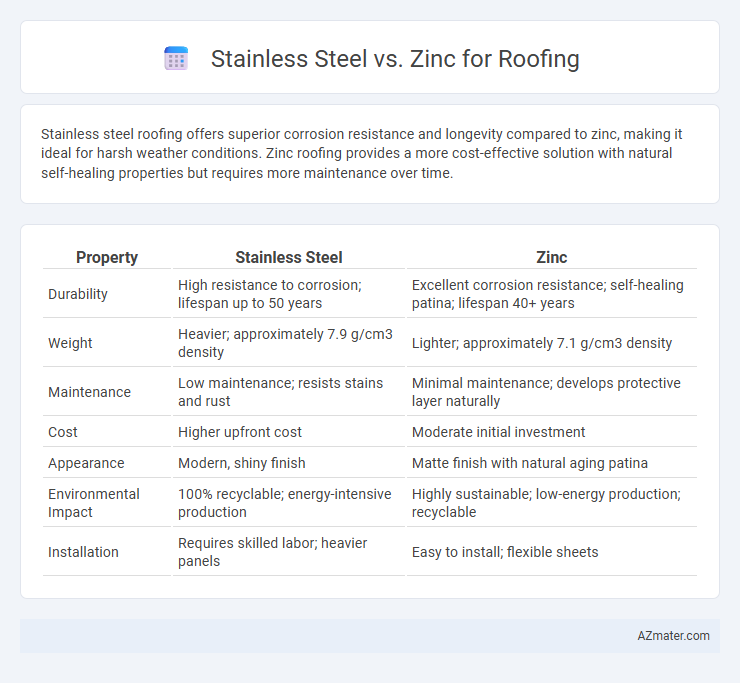Stainless steel roofing offers superior corrosion resistance and longevity compared to zinc, making it ideal for harsh weather conditions. Zinc roofing provides a more cost-effective solution with natural self-healing properties but requires more maintenance over time.
Table of Comparison
| Property | Stainless Steel | Zinc |
|---|---|---|
| Durability | High resistance to corrosion; lifespan up to 50 years | Excellent corrosion resistance; self-healing patina; lifespan 40+ years |
| Weight | Heavier; approximately 7.9 g/cm3 density | Lighter; approximately 7.1 g/cm3 density |
| Maintenance | Low maintenance; resists stains and rust | Minimal maintenance; develops protective layer naturally |
| Cost | Higher upfront cost | Moderate initial investment |
| Appearance | Modern, shiny finish | Matte finish with natural aging patina |
| Environmental Impact | 100% recyclable; energy-intensive production | Highly sustainable; low-energy production; recyclable |
| Installation | Requires skilled labor; heavier panels | Easy to install; flexible sheets |
Introduction to Roofing Materials
Stainless steel offers superior corrosion resistance and durability compared to zinc, making it ideal for harsh weather conditions in roofing applications. Zinc provides a natural patina that protects its surface and ensures long-lasting performance while being more cost-effective. Both materials are lightweight and recyclable, contributing to sustainable roofing solutions.
Overview of Stainless Steel Roofing
Stainless steel roofing offers superior corrosion resistance, durability, and low maintenance compared to zinc, making it ideal for harsh environments and coastal areas. Its high tensile strength and resistance to extreme weather conditions ensure a longer lifespan, typically exceeding 50 years. The reflective properties of stainless steel also enhance energy efficiency by reducing heat absorption in buildings.
Overview of Zinc Roofing
Zinc roofing offers exceptional durability and natural corrosion resistance, making it a sustainable choice for long-lasting protection against harsh weather conditions. Its self-healing patina develops over time, enhancing resistance to scratches and environmental pollutants. Zinc is lightweight and flexible, allowing for intricate designs and reducing structural load compared to heavier materials like stainless steel.
Durability Comparison: Stainless Steel vs Zinc
Stainless steel roofing offers superior durability due to its high resistance to corrosion, extreme weather, and physical impacts, making it ideal for harsh environments. Zinc roofing provides excellent longevity with natural self-healing properties and corrosion resistance, but it may be prone to patina development and less impact resistance compared to stainless steel. Overall, stainless steel outperforms zinc in durability for roofing applications, especially in areas with severe environmental stress.
Weather Resistance and Corrosion Protection
Stainless steel roofing offers superior weather resistance due to its high chromium content, which forms a passive layer preventing rust and corrosion even in harsh environments. Zinc roofing provides excellent corrosion protection through its self-healing patina, which regenerates when scratched, making it ideal for coastal and acidic rain-prone areas. Both metals withstand extreme weather conditions, but stainless steel typically requires less maintenance and offers longer-lasting durability against corrosion.
Aesthetic Differences and Design Flexibility
Stainless steel roofing offers a sleek, modern appearance with its smooth, reflective surface that resists discoloration and maintains a polished look over time. Zinc roofing provides a distinctive matte finish that naturally develops a protective patina, enhancing its rustic and aged aesthetic appeal. Design flexibility favors zinc due to its malleability, allowing for complex shapes and custom profiles, while stainless steel is better suited for simpler, streamlined designs.
Installation Methods and Ease
Stainless steel roofing panels require specialized fasteners and careful alignment due to their hardness and durability, often involving pre-drilled holes and precision cutting tools, which can extend installation time but ensures superior longevity. Zinc roofs offer greater malleability, allowing easier shaping and fitting around complex roof geometries with standard tools and conventional fastening methods, significantly simplifying the installation process. Both materials benefit from professional installation to maximize performance, but zinc typically provides a faster, more adaptable installation experience compared to stainless steel.
Cost Analysis and Long-Term Value
Stainless steel roofing typically has a higher upfront cost compared to zinc, averaging about $10 to $15 per square foot versus zinc's $8 to $12 per square foot. Despite the initial expense, stainless steel offers superior durability, corrosion resistance, and a lifespan exceeding 50 years, which enhances long-term value by reducing maintenance and replacement costs. Zinc roofs, while more affordable initially and self-healing against scratches, generally require more frequent upkeep and have a lifespan of around 40 to 50 years, influencing overall cost-effectiveness over time.
Environmental Impact and Sustainability
Stainless steel roofing offers superior durability and corrosion resistance, leading to a longer lifespan and reduced material waste compared to zinc. Zinc, while also recyclable, tends to have a slower oxidation process that naturally forms a protective patina, minimizing the need for additional coatings and lowering maintenance emissions. Both materials contribute to sustainability through recyclability, but stainless steel's longer service life and resistance to degradation often result in a lower overall environmental footprint.
Maintenance Requirements and Lifespan
Stainless steel roofing offers superior corrosion resistance, requiring minimal maintenance and lasting up to 50 years or more, making it a highly durable choice. Zinc roofing develops a protective patina over time that reduces corrosion, demanding low maintenance and typically lasting 80 to 100 years. Both materials provide long-term performance, but zinc's self-healing properties contribute to an extended lifespan with minimal upkeep compared to stainless steel.

Infographic: Stainless steel vs Zinc for Roofing
 azmater.com
azmater.com